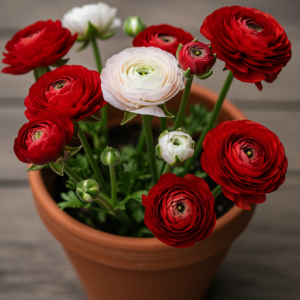
Ranunculus is a genus of flowering plants in the Ranunculaceae family, which includes over 600 species. These plants are known for their bright, multi-layered flowers that come in a variety of colors, including yellow, white, pink, red, and orange. The name “Ranunculus” comes from the Latin word for “little frog,” likely because many species grow near water, just like frogs.
Ranunculus plants are mostly herbaceous perennials, meaning they live for more than two years. However, some species are annuals or biennials. Here’s what makes them unique:
- Flowers: The blooms are the star of the show. They have multiple layers of delicate, papery petals that create a lush, rose-like appearance.
- Leaves: The leaves are usually green, glossy, and divided into lobes, giving them a feathery look.
- Height: Depending on the species, Ranunculus can grow anywhere from 6 inches to 2 feet tall.
- Growing Conditions: These plants thrive in cool climates and prefer well-drained soil, plenty of sunlight, and regular watering.
Spiritual and Symbolic Meaning
Ranunculus isn’t just a feast for the eyes—it also carries deep spiritual significance. In many cultures, the buttercup symbolizes charm, attractiveness, and radiant energy. Its bright, cheerful flowers are believed to bring light and positivity into one’s life.
Spiritual Uses:
- Meditation: Placing Ranunculus flowers in your meditation space can help create a calming and uplifting atmosphere.
- Rituals: Some people use the flowers in rituals to attract love, joy, and positive energy.
- Gifts: Giving someone a bouquet of Ranunculus can convey a message of admiration and charm.
Medicinal Uses
Ranunculus has been used in traditional medicine and homeopathy for centuries. The plant contains a compound called protoanemonin, which can be toxic in large amounts but has therapeutic properties when used in small, controlled doses.
Common Uses:
- Skin Conditions: Ranunculus extracts are used to treat rashes, blisters, and other skin irritations.
- Pain Relief: It’s known to help with nerve pain (neuralgia) and joint pain.
- Anti-inflammatory: The plant has natural anti-inflammatory properties, making it useful for reducing swelling and discomfort.
Caution: Ranunculus can be toxic if ingested, so it’s important to use it only under the guidance of a qualified homeopath or healthcare professional.
How to Use Ranunculus in Your Home
Ranunculus is a versatile plant that can brighten up any space, whether indoors or outdoors. Here’s how you can incorporate it into your home:
Where to Place Ranunculus:
- Indoors: Place potted Ranunculus near a sunny window or under a grow light. They make beautiful centerpieces for dining tables or coffee tables.
- Outdoors: Plant them in garden beds, borders, or containers. They’re perfect for adding a pop of color to your patio or balcony.
What It Brings to People:
- Beauty: The vibrant flowers instantly elevate the aesthetic of any space.
- Joy: Their cheerful appearance can boost your mood and create a positive atmosphere.
- Air Quality: Like many plants, Ranunculus helps purify the air, making your home healthier.
Pros and Cons of Growing Ranunculus
Before you decide to grow Ranunculus, it’s important to weigh the pros and cons:
Pros:
- Stunning Flowers: The blooms are incredibly beautiful and come in a wide range of colors.
- Versatile: Can be grown indoors or outdoors.
- Medicinal Uses: Offers homeopathic benefits when used correctly.
Cons:
- Toxicity: The plant is toxic if ingested, so it’s not suitable for homes with pets or small children.
- Specific Care Needs: Requires well-drained soil, regular watering, and plenty of sunlight.
- Pests: Can attract aphids and spider mites if not properly cared for.
What to Pay Attention To
To keep your Ranunculus healthy and thriving, keep these tips in mind:
- Watering: Water regularly but avoid overwatering, as this can lead to root rot.
- Sunlight: Ensure the plant gets at least 6 hours of sunlight daily.
- Pests: Check for aphids and spider mites, especially if growing indoors.
- Toxicity: Keep the plant out of reach of pets and children.
How to Propagate Ranunculus
Ranunculus can be propagated in three main ways: by seeds, division, or tubers. Here’s a step-by-step guide for each method:
1. Seed Propagation:
- Step 1: Sow seeds in well-drained soil in early spring.
- Step 2: Lightly cover the seeds with soil.
- Step 3: Keep the soil moist but not waterlogged.
- Step 4: Transplant the seedlings once they’re strong enough.
2. Division:
- Step 1: Dig up the plant in early spring or fall.
- Step 2: Carefully separate the tubers, ensuring each has at least one growth point.
- Step 3: Replant the divisions in prepared soil.
3. Tuber Propagation:
- Step 1: Soak the tubers in water for a few hours before planting.
- Step 2: Plant the tubers with the claw-like ends facing downward.
- Step 3: Water thoroughly after planting.
Ranunculus vs. Similar Plants
| Plant Name | Definition | Meta Title | Tags |
|---|---|---|---|
| Ranunculus | Vibrant, multi-petaled flowers known for their beauty and charm. | “Ranunculus: Beauty and Charm in Your Garden” | Ranunculus, buttercup, flowers, gardening, homeopathy |
| Tulip | Spring-blooming perennial with cup-shaped flowers. | “Tulips: Spring’s Favorite Bloom” | Tulip, flowers, gardening, spring blooms |
| Rose | Classic flower symbolizing love and beauty. | “Roses: Timeless Symbols of Love” | Rose, flowers, gardening, symbolism |
| Peony | Large, fragrant flowers often used in floral arrangements. | “Peonies: Fragrant Garden Giants” | Peony, flowers, gardening, fragrance |
| Daisy | Simple, cheerful flowers with a central disc and radiating petals. | “Daisies: Cheerful Garden Staples” | Daisy, flowers, gardening, simplicity |
Ranunculus is a truly remarkable plant that offers beauty, spiritual meaning, and practical uses. Whether you’re a seasoned gardener or a beginner, this plant is a wonderful addition to any home or garden. With proper care, it will reward you with stunning blooms and a touch of natural elegance.